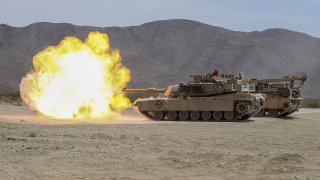How the U.S. Navy Moves Killer M1 Abrams Tanks to War
And those capabilities will now be enhanced thanks to new investments in new Expeditionary Fast Transport (EPF) vessels
Moving 70-ton Abrams tanks across the ocean at 35knots, transporting 600 tons of cargo 1,200 nautical miles, and delivering Special Operations Forces from a “sea-basing” tactical vantage point are all missions now being performed by the Navy’s growing fleet of Expeditionary Fast Transport (EPF) vessels.
While officially termed “non-combatant” ships, EPF ships are not themselves armed with weapons but instead built for fast humanitarian transport, disaster relief and other high-speed missions. However, the ships are intended to support major combat operations as well, as they can “roll-on/roll-off” armored vehicles, large numbers of armed soldiers or marines and, if needed, a group of drones.
The Navy has now awarded EPF-builder Austal USA a more than $230 million deal to build a new EPF 15. The Navy has already received its 12th EPF from AUSTAL USA, and EPF 13 is already underway. EPF 12, called USNS Newport, will be owned and operated by Military Sealift Command.
High-speed maneuver, coupled with heavy equipment transport technology, introduces some interesting tactical advantages to Maritime warfare. For example, operating with a range of twelve hundred miles can enable crucial transport without having to operate large, deep-draft big-deck ships in high-risk areas.
The speed of the vessels also align with the Navy’s Distributed Maritime Operations concept, a strategy intended to maximize warfare reach through the integrated use of drone boats, advanced networking, long-range weapons, and dispersed or disaggregated attack. Certainly, a less condensed force is a force less vulnerable to concentrated enemy fire.
The EPFs can also rely upon advanced speed and maneuverability to support amphibious attacks as well, by offering certain kinds of sea-basing oriented fast-attack options and bringing follow-on support forces, vehicles and supplies once a beachhead has been secured.
Special Operations Forces often need to move quickly in smaller groups, yet they also need supplies, weapons, equipment, and even platforms such as fast-moving tactical vehicles. Given this, there are mission objectives which small groups of SOF forces may benefit greatly from an EPF for fast mission attacks they are not able to accomplish with eleven-meter Rigid Inflatable Boats which naturally cannot transport equipment.
An Osprey launched from an amphibious ship or offshore sea base may wish to conduct Mounted Vertical Maneuver operations wherein Marines drop in behind enemy lines to gather intelligence, support friendly troops of a launch targeted, covert attacks. Missions of this kind would be massively fortified by an ability for a fast transport vehicle such as an EPF to lend after-landing support. Existing Navy Ship-to-Shore connectors can transport Abrams tanks, yet one at a time. Having EPFs makes things faster.
Perhaps a future massive amphibious assault would use Abrams tank-carrying EPFs, 155 towed artillery, thousands of soldiers, new Optionally Manned Fighting Vehicle infantry carriers and ground-attack robots. Such an attack would happen in coordination with overhead F-35 and F-22 air support, suppressive fire from land-attack Navy surface ships, and scores of Amphibious Assault Vehicles traveling from ship to shore.
Kris Osborn is the defense editor for the National Interest. Osborn previously served at the Pentagon as a Highly Qualified Expert with the Office of the Assistant Secretary of the Army—Acquisition, Logistics & Technology. Osborn has also worked as an anchor and on-air military specialist at national TV networks. He has appeared as a guest military expert on Fox News, MSNBC, The Military Channel, and The History Channel. He also has a Masters Degree in Comparative Literature from Columbia University.

